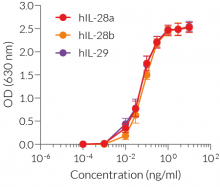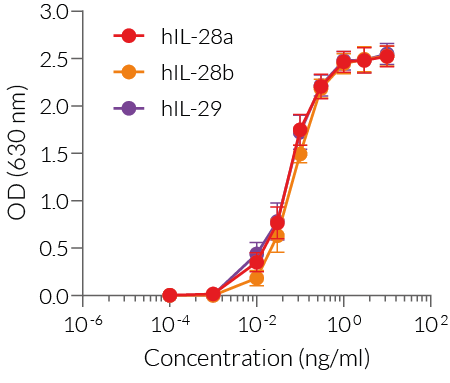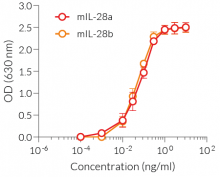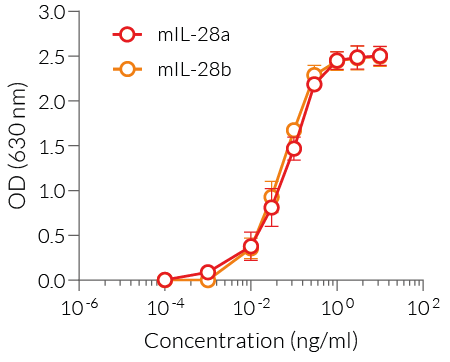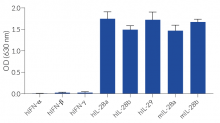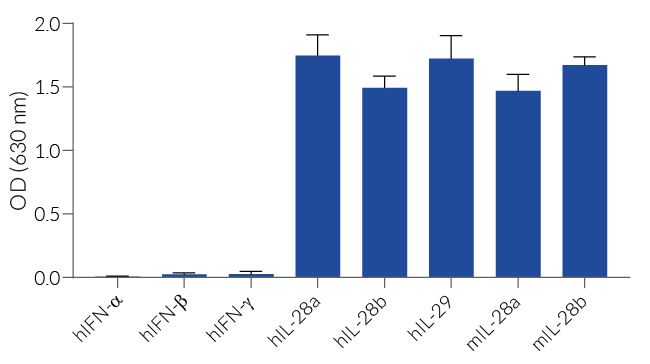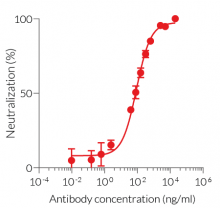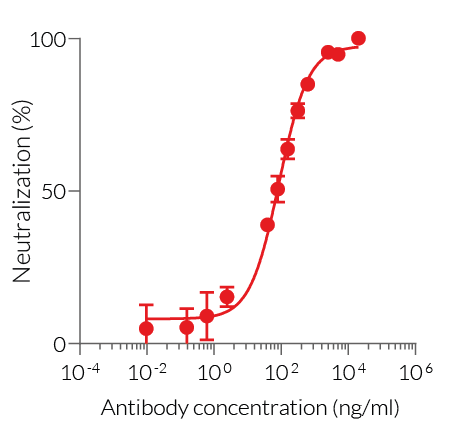IFN-λ Reporter HEK 293 Cells
| Product | Unit size | Cat. code | Docs. | Qty. | Price | |
|---|---|---|---|---|---|---|
|
HEK-Blue™ IFN-λ Cells Interferon-lambda Reporter Cells |
Show product |
3-7 x 10e6 cells |
hkb-ifnlv2
|
|
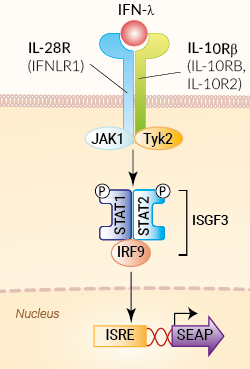
HEK-Blue™ IFN-λ Cells signaling pathway
Human Type III IFNs Reporter Cells
HEK-Blue™ IFN-λ cells were engineered from the human embryonic kidney HEK 293 cell line to detect bioactive human type III interferons, also known as IFN-λ (e.g. IL-28a, IL-28b, IL-29), by monitoring the activation of the ISGF3 pathway. The IFN-λ family is essential to the anti-viral response at epithelial barriers [1, 2]. They bind a cell-surface receptor, composed of two subunits, IFNLR1 and IL10β, which are associated with TyK2 and JAK1, respectively [1].
Description:
HEK-Blue™ IFN-λ cells were generated by stable expression of the genes encoding the human IFNLR and IL10R, together with the STAT2, IRF9, and a STAT1/2-inducible secreted embryonic alkaline phosphatase (SEAP) reporter to obtain a fully active type III IFN signaling pathway. The other genes of the pathway (JAK1, TyK2, and STAT1) are naturally expressed by these cells. STAT1/2-dependent SEAP activity is readily assessable in the supernatant using QUANTI-Blue™ Solution, a detection reagent. This activation of HEK-Blue™ IFN-λ cells can be blocked with a neutralizing monoclonal antibody, such as anti-hIL-29-IgG and anti-hIL-28-IgG mAbs. Of note, HEK-Blue™ IFN-λ cells do not respond to human type I and type II IFNs (IFN-α/β/γ; see figures).
Key Features:
- Fully functional IFN-λ signaling pathway
- Strong response to human (h) and murine (m) IFN-λ
- Unresponsive to IFN-α/β (type I IFN) and IFN-γ (type II IFN)
- Readily assessable SEAP reporter activity
Applications:
- Detection of human and murine IFN-λ
- Screening of anti-IFN-λ and anti-IFNLR antibodies
References:
1. Lazear HM. et al., 2015. Interferon-λ: Immune Functions at Barrier Surfaces and Beyond. Immunity. 43(1):15-28.
2. Lee S. & Baldridge MT., 2017. Interferon- Lambda: A Potent Regulator of Intestinal Viral Infections. Front Immunol. 8:749.
Specifications
Antibiotic resistance: Blasticidin, Puromycin, Zeocin®
Growth medium: DMEM, 4.5 g/l glucose, 2 mM L-glutamine, 10% (v/v) heat-inactivated fetal bovine serum, 100 U/ml penicillin, 100 µg/ml streptomycin, 100 µg/ml Normocin™
Guaranteed mycoplasma-free
Detection ranges:
- 0.01 - 10 ng/ml for human (h) IL-28a (IFN-λ2), hIL-28b (IFN-λ3), hIL-29 (IFN-λ1)
- 0.01 - 10 ng/ml for murine (m) IL-28a (IFN-λ2) and mIL-28b (IFN-λ3)
This product is covered by a Limited Use License (See Terms and Conditions).
Back to the topContents
- 1 vial containing 3-7 x 106 cells
- 1 ml of Blasticidin (10 mg/ml)
- 1 ml of Puromycin (10 mg/ml)
- 1 ml of Zeocin® (100 mg/ml)
- 1 ml Normocin™ (50 mg/ml)
- 1 ml of QB reagent and 1 ml of QB buffer (sufficient to prepare 100 ml of QUANTI-Blue™ Solution, a SEAP detection reagent)
![]() Shipped on dry ice (Europe, USA, Canada, and some areas in Asia)
Shipped on dry ice (Europe, USA, Canada, and some areas in Asia)
Details
The IFN-λ family is essential to the antiviral response at epithelial barriers [1,2]. In humans, this family comprises four distinct proteins called IFN-λ1 (interleukin-29, IL-29), IFN-λ2 (IL-28A), IFN-λ3 (IL-28B), and the poorly secreted IFN-λ4. In mice, two functional orthologs (IL-28A and IL-28B) have been described. IFN-λs are produced when a viral infection is sensed by pattern recognition receptors. IFN-λs bind to a heterodimeric receptor formed by the assembly of IFNLR1 and IL10Rβ. This leads to the recruitment of the Janus kinases, JAK1 and TyK2, and phosphorylation of STAT1 and STAT2, which then dimerize and interact with IFN regulatory factor 9 (IRF9), forming the ISGF3 complex. ISGF3 binds to IFN-stimulated response elements (ISRE) in the promoters of IFN-stimulated genes (ISG) to regulate their expression.
1. Lazear HM. et al., 2015. Interferon-λ: Immune Functions at Barrier Surfaces and Beyond. Immunity. 43(1):15-28.
2. Lee S. & Baldridge MT., 2017. Interferon- Lambda: A Potent Regulator of Intestinal Viral Infections. Front Immunol. 8:749.





